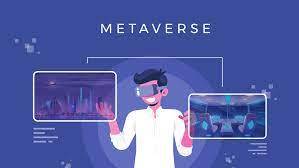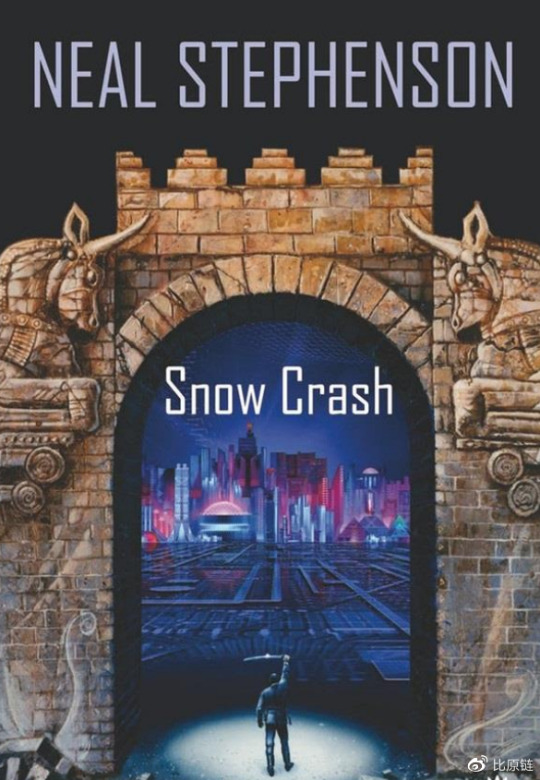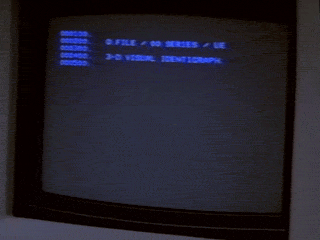#Inter-planetary File System
Explore tagged Tumblr posts
Text
Addendum: Key Characters and Groups
These books have a large cast, and so for the sake of brevity, I will only be mentioning characters who are likely to show up/be mentioned in next book. Hopefully I won't miss anyone!
(Again, there are spoilers!)
====== Murderbot: Snarky, depressed, half-human half-robot who's adjusting to freedom. Dr. Ayda Mensah: Brave and compassionate research scientist, ex-planetary admin of the Preservation Alliance. Needs therapy.
ART/Perihelion: Extremely advanced AI teaching and research vessel that secretly conducts anti-corporate espionage. Threatened to bomb a colony to rescue Murderbot.
Amena: Mensah's teenage daughter. Originally resentful of Murderbot, the two became fire-forged friends. Has a particular talent for mediating Murderbot and ART's arguments. Pin-Lee: The foul-mouthed and foul-tempered PresAux lawyer.
Dr. Ratthi: A kind-hearted and somewhat ditzy PresAux biologist. Skilled at navigating inter-personal issues.
Dr. Arada: An optimistic and sweet-hearted PresAux biologist. Promoted to survey head in Network Effect. Married to Overse.
Overse: 'Scanning expert' of the PresAux team. More of a realist than her wife, Arada.
Thiago: Linguist of the Preservation Survey, and Dr. Mensah's brother-in-law. Suspected Murderbot of emotionally manipulating Mensah, but re-evaluated after getting to know it better.
SecUnit Three: A very newly rogue SecUnit and the only survivor of a set of three. Might not always understand what's going on, but willing to help anyway!
Murderbot 2.0: A killware copy of Murderbot with the original's attitude combined with ART's know-it-all personality. Went out in a blaze of glory against TargetControlSys.
TargetControlSys: The operating system of a so-called alien hive-mind running on a mixture of crystal fungi and human wetware. Humans contaminated by it often have grey skin and oddly thin builds. Infected colonists tried to spread the infection by kidnapping ART and inserting control-chips into peoples' necks.
Barish-Estranza: Company that's attempting to take ownership of the abandoned colony (and "employ" any surviving colonists). Not thrilled about the alien contamination.
Eletra: Rank and file Barish-Estranza employee. Was kidnapped and chipped by infected colonists. Spent a significant time on ART, but due to medical tampering, has a fuzzy memory of the whole ordeal. Returned to Barish-Estranza.
Supervisor Leonide: The apparent leader of the Barish-Estranza colony retrieval team. Tried to kidnap Arada; fucked around and found out.
Iris: A young augmented woman and "ART's favourite". Cool under pressure.
Captain Seth: ART's captain and Iris's father.
Martyn: Member of ART's crew, biologist, and Iris's other father.
ART's Crew: Also includes Karime, Kaede, Matteo, and Turi. Dr. Bharadwaj: Scientist Murderbot rescued from becoming worm chow, but who was seriously injured in the aftermath. Developing an AI-rights documentary with interviews featuring Murderbot.
Dr. Gurathin: The augmented data analyst of the PresAux. While initially mistrustful of Murderbot, now is very ride-or-die.
Murderbot Diaries Book Summaries
The release of the 7th book in the Murderbot Diaries series, System Collapse, approaches in November!
I've seen at least one person looking for a summary of past events... So I've made just that! If it's been a while since you read previous books (or you just like hopping into series half-way through), this will get you up to speed!

That said, this absolutely has spoilers, so if that's not your jam, turn away now.
====
Short Story – Compulsory: A recently-rogue Murderbot decides on a whim to rescue a miner who falls into a ventilation shaft. We see its developing love of Sanctuary Moon and what is implied to be the first time it violated its orders to protect someone.
All Systems Red (ASR):
Murderbot is the contractually-obligated security guard on a survey of "surprisingly nice" scientists. Dr. Mensah particularly impresses Murderbot for her level head and kind nature. It turns out their survey is being sabotaged by the cut-throat corporation GreyCris, who don't want them uncovering alien remnants. Murderbot and the scientists go back-and-forth protecting one another. The survey team discover that it's rogue. After some initial tension, they accept it as a team-member. They escape GreyCris, although Murderbot nearly dies in the process. When it wakes up again, the scientists have bought/freed it. In the name of self-actualization, Murderbot runs away.
Artificial Condition (AC): Murderbot sets off to investigate Ganaka Pit, the facility where it supposedly killed a large number of its own clients. On the way, it discovers the spaceship it's travelling on actually dangerously hyper-intelligent. After some initial threats/tension, the two bond over TV. The Asshole Research Transport (ART) helps disguise Murderbot as a human. With ART's help, Murderbot uncovers that the mass death was a tragic accident caused by ComfortUnit malware. Posing as a human, the pair help rescue a trio of researchers and their data from their shitty ex-boss, and set a ComfortUnit free.
Rogue Protocol (RP):
On an impromptu quest to get blackmail on GreyCris for Dr. Mensah's ongoing legal battle, Murderbot investigates an abandoned terraforming facility. It meets a cheerful robot named Miki who immediately declares themselves friends. Miki is helping a human assessment team who become imperiled when they're attacked both by CombatBots and their own double-dealing human security. Murderbot reflectively rescues them, posing as a Definitely Normal SecUnit, although the team's leader clearly sees through that claim. Murderbot manages to collect the intel on GrayCris and protect the humans, but not before Miki performs a heroic sacrifice.
Exit Strategy (ES):
After discovering Dr. Mensah has been kidnapped by GreyCris, Murderbot rushes to save her. This forces it to re-unite with the other survey members; Pin-Lee, Ratthi, and Gurathin. While unsure of each other, the team manage to rescue their friend. Murderbot attempts a self-destructive last-stand against a CombatSecUnit, only for the humans to save its ass. The team escapes on a company gunship, but not before Murderbot melts its brain fighting off killware. When it rebuilds its systems, it decides to stay with its humans in the Preservation Alliance for a while.
Short Story - Home, Range, Niche, Territory:
Shortly after Exit Strategy, Dr. Mensah reflects on her time in captivity and her new friendship with SecUnit. Apparently she's been avoiding getting treatment for her extensive emotional trauma. She has a panic attack when she's cornered by a journalist, who's scared off by Murderbot.
Fugitive Telemetry (FT): A human is found dead. Murderbot is called in as a consultant on the case, in the hopes of building good will with Preservation Security. Eventually it manages to prove itself, particularly after it succeeds in a daring rescue of kidnapped corporate refugees. One of the refugees realises it's a SecUnit and shoots it. The dead human turns out to have been a liberator of indentured labourers, and the killer was actually the Port Authority robot Balin, who was secretly a disguised CombatBot acting on outside orders. The local bot community intervenes to stop Balin from hurting anyone else.
Network Effect (NE):
Murderbot is providing security for a Preservation Alliance survey which goes south when raiders attack and try to take Dr. Mensah's brother-in-law, Thiago, hostage. It then goes doubly south when, on the way home, the team's ship gets attacked by... ART?
It appears that ART has been deleted and its crew has gone missing, replaced with mysterious grey people. While protecting a team of its humans, including Dr. Mensah's teenage daughter Amena, Murderbot manages to reboot ART. ART kills the grey humans but refuses to let everyone go until and unless they help it retrieve its crew. Everyone reluctantly agrees, but Murderbot is pissed.
Eventually Murderbot and ART make up. Then they create a sort-of-baby in the form of a killware copy of Murderbot who dubs itself Murderbot 2.0. Half of ART's missing crew is found on a local planet's surface, though Murderbot is captured while helping them escape. Murderbot 2.0 manages to rescue the other half from a spaceship with the help of the newly freed SecUnit 3. The local colonists are discovered to have gone a liiiiitttle bit kooky due to infection via an alien fungus. ART threatens to bomb their colony to get Murderbot back. Murderbot gets infected, but Murderbot 2.0 does a self-sacrificial attack to save it and destroy the fungi's primary host. Meanwhile, the humans, ART, and SecUnit 3 work together to rescue Murderbot without any more bloodshed.
Murderbot has a bit of an epiphany that all its various friends do in fact love and care for it. When an understandably pissed and confused Dr. Mensah shows up like a month later, the groups decide on forming a mutual partnership. Murderbot tells Dr. Mensah that it would like to work with ART for a little while.
166 notes
·
View notes
Photo








Rise Or Fall? The Complete Understanding Of Metaverse From The Philosophical, Cultural, Scientific And Social Perspectives
There are many recent popular films on ‘Metaverse’: Everything Everywhere All at Once, Doctor Strange in the Multiverse of Madness and Free Guy.
Technology company WayRay promotes its new kind of 'human world' as this: humankind has long been fascinated with a different reality—a different plane of existence, a different identity and a new perspective. To interact with a different reality might have been a dream decades ago, but now it is as real as the phone you are holding today. The technology is now mature enough, and we can all reach into the ‘Metaverse’.
What exactly is a ‘Metaverse’? It was said, “The meta-verse ('Meta’ + ‘Universe') is a virtual ‘reality space’ on the internet where a user can create a ‘human identity’ to live, interact and play, as well as experience things that he could always do in the real world." Metaverse will be another globe running parallel to and circumventing the existing world. The term came from a science fiction Snow Crash by Neal Stephenson in 1992 and the story depicted a virtual world on the internet that has buildings, roads, parks and shopping malls in which we could enjoy ‘a collateral life’.
It was pointed out Metaverse has 8 characteristics: (1) living under a virtual identity (2) getting along with new virtual ‘co-beings’ (3) instant and spontaneous movements by you commanding your extended identity in the virtual environment (4) an ‘as-if-real’ immersive experience in the virtual world (5) doing the great things which are humanly impossible for you to try in real life such as flying and roles transforming (6) the self-functioning economy of Metaverse by which you can become rich (7) vast supply of fascinating games and contents; and (8) co-building a ‘post-modern human civilization’.
Metaverse was made possible by scientific achievements. The advent of new technologies like 5G or 6G mobile network, Web 3.0, AI (Artificial Intelligence), VR (Virtual Reality), AR (Augmented Reality) and MR (Mixed Reality) solved many technical problems. The necessary equipment to operate Metaverse is expensive and includes special headset, personal computer, mobile phone, web, projection and kiosk. The ‘money’ transactions there involve innovative softwares like De-Fi (Decentralized Finance), IPFS (Inter-planetary File System) and NFT (Non-fungible Token). Mark Zuckerberg announced that ‘Meta’ (formerly known as Facebook) would soon file patent applications for a number of useful devices such as a pair of ultra-sensitive gloves to make 'Meta' bodily experience almost real. Can you afford all these?
Perhaps I am old, if not senile. The real world is already burdensome enough on a daily basis. My sure horror will come from the additional labour and toil associated with consuming a few hours per day on living in another artificial Metaverse. I get enough, if not more than enough, friends. Why should I meet more virtual people in the disguise of different identities and a lot of them may be crooks? I, nevertheless, envy the energetic ones who can handle two lives and two worlds.
I ask around to find out my friends’ interest on Metaverse. A said, “Communication technology simply makes people unnecessarily busy!” B said, “It’s cool! I want to be a powerful KOL or KOC in such a brave new world.” C said, “If I can make lots of money there, why not? I’m planning to buy some lands there.” D said, “I will be horrified when my 22-year-old girlfriend in Metaverse turns out to be an 80-years-old man!” E said, “Would it be lawful or immoral to attend a drug party in Metaverse?” F said, “How exciting it will be since I can hold a big concert there in the face of Michael Jackson?” G said, “I will transform myself into the most gorgeous girl there and attract loads of boyfriends!” H said, “I am afraid of sexual harassment. An English female beta tester was once groped by a stranger on Horizon Worlds!”
There is a famous philosophical story (莊周蝶夢)(Zhuang Zhou & Butterfly)of our ancient scholar Zhuangzi(莊子)(about 369 to 286 B.C.) that every Chinese knows. Zhuang dreamed that he was a butterfly. He suddenly woke up and found he was still himself, solid and human. He was puzzled and left us with his great theory of Taoism. “Am I really a man that dreamed of being a butterfly or whether I am a butterfly dreaming as a man?” This great Chinese thinker tried to challenge what we took as real might be unreal and what was unreal might be real. Perhaps he was the first one who inspired us on virtual reality thousand years ago. The French philosopher R Descartes (1596-1650) said, “No certain indications by which we may clearly distinguish wakefulness from sleep.” The development of Metaverse as the popular ‘second reality’ will lead more people to pursue a hot debate: can young people in the 23rd century choose to live in a virtual world of butterflies and refuse to live in a human world?
The other amazing Chinese ancient fairy tale protagonist is ‘The Monkey King’. It is based on the ancient story Journey to the West(西遊記) about a famous monk Xuanzang (玄奘) (602-664) who travelled on foot from China to India for the authentic Buddhist scriptures, escorted by Monkey King(孫悟空). This monkey was clever and rebellious. He acquired an immortal life and could transform him into seventy-two different identities in different situations at the same time. Riding clouds in the sky as a vehicle (Monkey King today will probably use Internet as his vehicle), he was able to travel 108,000 miles by a single somersault to meet friends. Would the Metaverse users dream of being a butterfly or Monkey King which were all old prophecies of ‘virtual reality’.
Many predict that your digital existence will become more important than your physical life. In the Metaverse, your life is fascinating with all that you can enjoy. But on earth, you may be lonely and miserable. Virtual life may be joyful. A real life can be sad. Nevertheless, the more humans lose themselves in a non-existent world, the more Artificial Intelligence technology will control us in future. I do not want to live in the virtual world because it will not give me a nice haircut! Do you? Happiness boils down to simplicity.
MLee
Chinese Version 中文版: https://www.patreon.com/posts/shi-kai-shi-huan-67507595?utm_medium=clipboard_copy&utm_source=copy_to_clipboard&utm_campaign=postshare
Movie “Everything Everywhere All at Once” Trailer HK https://youtu.be/E7qroZ-IulA Acknowledgement – A Really Happy Film
Movie “Free Guy” Trailer https://youtu.be/_vBOPZBPOjo Acknowledgement-20th Century Studios HK
What is Metaverse https://youtu.be/ZhD0FtWSiRo Acknowledgement-BBC News
Metaverse development in Korea https://youtu.be/ov_SCy-cKJc Acknowledgement-BBC News
Metaverse – Virtual Teresa Teng https://youtu.be/rN2PNMGtn2Q Acknowledgement-TBV News
Spent 100 days in Metaverse https://youtu.be/mufeRQYgqZc Acknowledgement-Ryan Trahan
Metaverse Song 《元宇宙》歌 https://youtu.be/qwWL58XcIYA Acknowledgement-Leslie Tsang
#Zhuangzi莊子#Xuanzang 玄奘#Monkey King孫悟空#Mark Zuckerberg#Neal Stephenson#Zhuang Zhou & Butterfly莊周蝶夢#Journey To The West西遊記#Free Guy#Snow Crash#Artificial Intelligence#Mixed Reality#Augmented Reality#Virtual Reality#Horizon Worlds#Decentralized Finance#Inter-planetary File System#Non-fungible Token#Everything Everywhere All at Once#Doctor Strange in the Multiverse of Madness
19 notes
·
View notes
Text
Civilizations and Space Powers Guide
This is a quick-and-dirty guide to the powers that have a major presence within the Milky Way Galaxy. The list covers general technological achievement, but there's more to that when covering such species. Some have vast territories despite being weak, while others rule the universe from a single planet. Things can and do 'punch up' against higher 'tier' foes due to logistic and strategic advantages they have other each other.
Kardashev Type 1 (Low)
These civilizations are more advanced than earth and may venture into space on the regular -- up to other planets in their system, but no further.
The Rogue Planet Mongo (Flash Gordon) - The "Rogue Planet" Incident is as much an extradimensional incursion as an interplanetary incident. When it first appeared in our solar system, using a combination of science and sorcery, This almost happened to earth were it not for the intervention of an earth football player, Alex "Flash" Gordon.
Possible Future: Mobile Suit Gundam
Possible Future: Martian Successor Nadesico
This is also the realm of the planetary romances. There are many stories in the Crossover Universe that require an inhabited solar system -- a fully inhabited Solar System. There are several ways to handle this and maintain the spirit of the Crossover Universe (IE: How can The X-Files and War of the Worlds co-exist?!). One could just barrel through and treat it like its superhero comics ("I thought you didn't believe in Vampires?" "I do believe in crazy people."), or the information of those inhabited planets is suppressed by some form of conspiracy (Note: The bigger a conspiracy is, the more likely it is to break down and leak out the Truth). As technology advances, the idea of the Crossover Universe resembling the "World Outside Your Window" grows less and less supportable, so someone playing around in the Crossover Universe should feel free to just have fun with it! Another is to place these inhabited versions of the Solar System as being from an alternate dimension. This dimension is theoretically also the home of Mongo, and each planet (and then some) has civilizations on it.
Mercury - Though there is life on Mercury, it is made up of metallic plants that live at the poles.
Venus/Amtor - There are humans of decent technological advancement here. Still, because of the heavy cloud cover, the 'water world' they inhabit has done more exploring into the ocean than beyond the clouds.
Earth - The inter-dimensional theory posits that Pellucidar, is in truth, the earth of this inhabited solar system's dimension.
Earth's Moon - Earth's moon is home to two underground societies. The Selenites, ant-like intelligence who live peacefully, and the horrible fungus-headed moon beasts, who serve Nyarlathotep.
Mars/Barsoom - Home to several sapient species, a world of fantastic possibilities, but is slowly dying. Further details are found elsewhere.
The Asteroid Belt - formerly a planet known as Thyoph, was destroyed by some cataclysm.
Jupiter - Jupiter is a gas giant here, but some of the moons are inhabited. One of them is called Eurobus by its inhabitants. A planet of high vulcanism and heavy cloud cover, two species inhabit the planet. One is the human-like Savators, who hide in invisible homes to escape their aggressors. Primarily, the "Skeleton Men", the Morgors, look like desiccated human mummies with thing slightly transparent skin and a metallic sheen.
Saturn - Cykranosh is the largest moon of Saturn. This dark world of fungus forests and mercury lakes is home to two cultures of Blemmyes, humanoid beings with no head, but a face in their chest. They call themselves either Bhlemphroim or Ydheem, depending on their culture, but are little more than agrarian.
Uranus/L'gy'hx - The cubical machine-like beings inhabit this planet keep to themselves, and their abhorrent rites of self-mutilation to Azathoth and Nyarlathotep were enough that the Goa'uld find them offensive and chased them from their native world.
Neptune - The natives call it Yaksh, as they call themselves. The fungus-like beings share the planet with several Great Old Ones as well.
Pluto/Yuggoth - The Beings from Yuggoth, the Mi-Go, are a greater power in the broader universe and are covered further below.
Kardashev Type 1 (Mid): Covers a wide variety of powers limited to travel within one galaxy. These are the 'local powers' of the Milky Way system. Up until 2005, the Goa'uld System Lords ruled the largest portions of the Milky Way Galaxy due to their superior method of interstellar travel and larger planetary base giving them more resources and logistical advantages over the others. However, each quadrant seems to have an 'up and coming' power that is growing to challenge it. Earth is one such place, but there are others.
The Borg Collective grows in strength moment by moment in the Delta quadrant but is otherwise a stronghold of the Goa'uld.
The Gamma Quadrant sees war with the Changelings battling for survival against the Kherubim, Spaceknights, and Sontarans. This Quadrant sees the least Goa'uld activity.
The Beta Quadrant has quite a few horrors running around, vying for control -- from the Mycenaeans to the Viltrumites. This keeps Goa'uld's presence to a minimum.
And the Alpha Quadrant is rampant with the little snakes.
The other powers are interstellar to their local star cluster and do not hold much territory in the Milky Way. Some are even fallen empires or are connected to once-great powers, meaning that despite holding so little territory, they have access to the tech they no longer understand fully that exceeds their normal limits. These include the Amazons, Zentradi, and Cybertronians.

Amazons (DC Comics) - Have higher technological abilities, but most of it is reliant on ancient technology they can maintain but not reproduce. They are also limited in power by their civilization being only a single planet. They have no interest in conquest but are fully prepared to defend themselves from even the Goa'uld if need be.
Borg/Cybermen (Star Trek/Doctor Who) - Even now are "High" on this scale particularly due to their adaptability and technological growth.
Changelings (Star Trek) - A rising power like the borg. Held back by being at war with several other species in their quadrant.
Cybertronians (Transformers) - Fallen from greatness and with a low population, they are dangerous, but not in the sense that they can operate in open war against the other powers. Their ability to hide as machines and their size makes even one Cybertronian more than a match for several squads of ground troops.
Goa'uld System Lords (Stargate) - Dominate the Galaxy due to Hyperdrive out-speeding Warp tactically (though Warp has strategic advantages over Hyperdrive), and having a larger resource base than any other power in the Galaxy. They can afford to lose legions in battle, other civilizations cannot.
The Zonders (King of Braves GaoGaiGar) - a blight on the galaxy, but only slowly gaining a foothold.
Kherubim/Kree/Shi'Ar (Marvel and DC Comics) - Powerful in their cluster, but fighting a losing war against the Changelings.
Klingons/Draconians (Star Trek/Doctor Who) - They have had warp travel since 930 CE by earth reckoning, but have only expanded slightly due to internal strife.
Kryptonians (Formerly, effectively extinct) - Their population is limited to less than a handful of colony ships -- one of which was destroyed by Xenomorphic infection, while another was taken by the entity known as Brainiac.
Majesdanians (Marvel) - A victim of the Changeling invasions, but they managed to survive as they could not mimic their energy forms. This planet is also home to the dreaded Colour Out of Space.
Mycenae Empire (Great Mazinger) - Dealt several major blows in failed invasions, they are licking their wounds and waiting for the next time to strike. They are one of the few species whose footsoldiers can take on transformers one on one -- or a squad of them.
Predators/Yaut'ja - The only ones we've seen are hunters. Some suspect their entire society is centered around it, but they could just be the equivalent of hunters in the United States -- office workers trying to reclaim some semblance of virility and power by hunting 'lesser' life forms.
Romulans (Star Trek) - They are another warp-capable species, but their speeds are slow, limiting their expansion.
Spaceknights (Marvel) - Fighting a losing war against the Changelings. They think they have won at the moment, but the Changelings are biding their time.
Stargate program (late series)
Sontarans (Doctor Who) - Currently, they will grow more advanced over time. They have had Warp for about 1000 years. They are a race of warriors, but also a race of clones. So, adaptation is difficult for them.
Vulcans (Star Trek) - Slowly exploring the galaxy, the Vulcans have been at Warp since the 9th century B.C.E. by earth's reckoning.
Viltrumites (Invincible) - A fading empire. They used their physical might to dominate a quadrant of the galaxy but were brought low by biological weaponry, so now the empire is a glass canon. Powerful, but there are so few true Viltrumites left as to be only on this scale.
Zentraedi (Macross) - More a roving threat than a civilization. All they know is the making of war, and are at war with everyone. They have the numbers to go against the Goa'uld, but do not make a concerted effort since they are technically at war with everything.
Zeta-Reticuli (The X-Files) - Prefer subterfuge rather than open combat.
Kardashev Type 1 (High): These powers tend to have power over or hold sway over a galaxy. There are very few native to the Milky Way Galaxy, though some of the nearby galaxies or galactic clusters have a few that can stray over to the Milky Way from time to time.
The Data Integrated Thought Entity (DITE) is native to the Milky Way, but wishes simply to observe and learn. As beings of energy and information, they observe the physical world rather than interfere with it more often than not.
The Light Giants of Nebula M78 are native to the Milky Way, but their reach only extends into the Alpha Quadrant. They defend it against the Goa'uld and other menaces, though they are severely limited due to their small population size. One 'agent' is usually sent to defend a planet, but given their power, this is actually possible. Still, as a power, they are deeply limited.
This leaves the Vajra as the true "Super Power" of the Milky Way after the Goa'Uld. However, they largely remain around the center of the Galaxy, where it is more difficult for other species to operate.
The other species listed are not native to the Milky Way Galaxy, inhabiting the Andromeda Galaxy or other Galaxies in the local cluster.
The Galactic Republic exists in a nearby galaxy to the Milky Way and can make its way over to us if they wished, but they tend to have their own problems...

Data Integrated Thought Entity (The Melancholy of Haruhi Suzumiya)
The Galactic Republic (Star Wars) - Triangulum Galaxy
Lloiger (Lovecraft) - Andromeda Galaxy
Nebula M-78 Light Giants (Ultraman)
Vajra (Macross Frontier)
Replicators (Stargate SG-1)/Extraterrestrial Living-Metal Shapeshifter - Ida and Othala Galaxies
Sky Canopy Domain (The Melancholy of Haruhi Suzumiya) - Ida Galaxy
The Galactus - The World Eater/Planet Killer. This singular entity deserves a spot on this list. Since it can match an entire civilization by itself, that should tell you what it's capable of. It travels the universe destroying inhabited and inhabitable planets one by one for its own purposes. It travels alongside a swarm of machines to more effectively extract energy from a planet, alongside a mothership. Conical in shape with an open maw in its forefront, the armor is solid neutronium and it expels antimatter to rip up planets bit by bit. It has come by earth once and was deactivated. Left to drift in space, but the thing is eternal and reactivated hundreds of years later. It was stopped again in the 23rd century by ramming a starship down the main vehicle's gullet. But that only will stop it for so long.
Kardashev Type 2 (Low): Few low-end Kardashev Type 2 civilizations remain, and fewer higher order civilizations survive... Thanks to the Dholes. The Space Monsters devour planets from within and end civilizations through their reproductive cycles. The Shadow Accords exist primarily to forge alliances for other species whenever the Dholes are spotted.
Or Galactus.

Dholes/Uchuu Kaiju (Gunbuster)
The most advanced of the remaining colonies of the Capellan/Eridanean (The Other Log of Phileas Fogg)
Kardashev Type 2 (Mid): These highly advanced civilizations have managed to overcome the Dholes and dominate their galaxy. Each of these have control over one (or two) galaxies in the local cluster. Some of these are actually dormant or extinct, leaving behind traces of their civilization for others to find... and make messes with.

Asgard (Stargate SG-1) - Probably the most benevolent race, who managed to protect a few planets in the Milky Way from Goa'uld aggression as they deal with the Replicators.
The Elder Things (Cthulhu Mythos) - They are the creators of the Stargate system. Other species took advantage of them being around first and now they are rare and scattered. They are also responsible for a lot of the problems in the Milky Way galaxy at least: the Zentradi, the Cybertronians, and the Protodeviln can all be laid as either their creations or the results of their science gone awry.
The Mi-Go (Cthulhu Mythos) - They are not native to this plane of existence, but use it as a 'safe' staging ground and harvest resources from planets secretly to further their machinations elsewhere.
The New Gods (DC Comics) - Though deities, they have a presence in the Milky Way galaxy. They are potent, but they are locked in a war with themselves, and only move to other worlds to gain an edge over their rivals. One of their numbers is said to be merely a mask of the Outer God Nyarlathotep.
The Terminus Collective (Icon) - This post-scarcity culture lives in a nearby galaxy and sometimes its ships get lost in our neck of the woods. They have been at peace for so long that they... have honestly forgotten how to fight a war to any meaningful degree. Any not cowed by their technological and physical abilities can easily gain the upper hand against them, but they are large enough and powerful enough not to worry about that happening... again.
Xothians (Cthulhu Mythos) - This is the name of Cthulhu's 'species'. Also known as "Space Spawn" they are one of the most powerful individual species in the galaxy, and many are worshiped as gods for it. Their motivations are unknown, but they seem to be dormant for now...
Kardashev Type 2 (High): The civilization of Ancient Belka was similar to its follow-up civilization, which relies more on magic to power its machinery. This means that they spend (and are located) in different dimensions as much as in space. As such, they don't really hold much territory in 'real' space.
Dimensional Administration Bureau (Magical Girl Lyrical Nanoha)
Kardashev Type 3 (Low): The Q go where they wish, when they wish, observing and meddling at times that make sense to them. The same applies to the Organians. They may be different cultures within the same species.
Q-Continuum/Organians (Star Trek)
Kardashev Type 3 (Mid): The Mu once dominated the galactic cluster, leaving all sorts of junk behind, though they originated on earth. This is partly why there are so many humanoids in the nearby systems.
Mu/Ancients (Stargate SG-1)/"The Lantern Corps" (DC Comics)/"The Nova Corps" (Marvel Comics)
Kardashev Type 3 (High): At this point, these beings don't really exist in space as we know it, but within Time. The Great Race of Yith has hidden in the distant future, only sending scouts and explorers to the past. And the Daleks... everything fears the Daleks.
Daleks
Great Race of Yith
Kardashev Type 4: Mastering time and space allowed the time lords to basically rule everything, and they chose not to. Like the Light Giants, their small population means that despite having guns that can remove a target from existence, they do not go to war often.
Time Lords
#Civiliations#Analysis#Crossover Universe#Cthulhu Mythos#Star Trek#Star Wars#Doctor Who#Stargate#Stargate SG-1#Magical Girl Lyrical Nanoha#the melancholy of haruhi suzumiya#DC Comics#Marvel Comics#DC#Marvel#Milestone Comics#Icon#Super Dimensional Fortress Macross#Macross#GaoGaiGar#Transformers#Gunbuster#Diebuster
25 notes
·
View notes
Text
What is IPFS? What is the future of IPFS?
Let the blogger introduce IPFS today!
To understand IPFS, you must first know what HTTP is, because the emergence of IPFS is iterative HTTP.
I think everyone is familiar with HTTP. When we need to open a website to search and download certain information, we use HTTP. It is the underlying hypertext transfer protocol. It was released in 1996, and it has been 25 years since its contribution to the world is obvious to all. But over time, people gradually discovered his shortcomings. His operating principle is to concentrate all data on a central server. The server must be on for 24 hours. The load pressure is extremely high, which can easily cause the system to crash and be vulnerable to DDOS attacks. Once the above problems occur, data loss and irreversibility will occur. I believe that when you search for a 404, it means that data is lost, deleted, or maliciously tampered with.
It is for this reason that the smart brains in the world begin to collide with each other. So in May 2014, Juan Benet, who graduated with a master's degree in computer science from Stanford University, founded the protocol laboratory. The protocol laboratory is a laboratory for research, development and deployment of network protocols. It is committed to building protocols, systems, and tools to improve the way the Internet works, and it focuses on how to store, locate, and transmit information. Its goal is to solve the shortcomings of the traditional Internet through new technologies, good user experience and open source methods, and IPFS was born.

The Chinese translation of IPFS is "Inter Planetary File System" (Inter Planetary File System), which is a basic point-to-point hypertext file transfer and storage protocol. Simply put, HTTP puts eggs in a large basket, while IPFS puts eggs in baskets all over the world.
The purpose of the birth of IPFS technology is to iterate HTTP technology to solve the above-mentioned drawbacks. IPFS stores files in multiple nodes close to users, and the storage is fragmented. Traditional DDoS attacks are invalid, files are more secure, the closer the distance, the faster the download speed, and the storage cost will be reduced. What's more advanced is that due to the use of blockchain technology, historical versions can be traced back and theoretically can be stored forever. So the emergence of IPFS is iterative HTTP, its technology is more advanced, the use cost is lower, and the operating conditions are more convenient.

Over time, IPFS technology has been used in many applications around the world. Internet giants are deploying IPFS, foreign countries such as Google, Microsoft, Oracle, Amazon, Facebook, Huawei, Ali, Tencent, JD, Baidu, etc., this also illustrates a problem. The global consensus on the value of IPFS is unified, because the emergence of this project is to replace HTTP, that is, to provide humans with safer, more efficient, and cheaper storage technology. Data is an important cornerstone for recording the development of human civilization and a weather vane for the development of human civilization in the future. Without data, there is no future. With the exponential growth of data generated by the rapid development of civilization and technology, data storage technology is also constantly iterating, just as the technological revolution develops to the information revolution. IPFS is the future of data storage.
For more good articles, you can follow the blogger, welcome everyone to like and communicate, or add the blogger's contact information. Scan the QR code below to add the corresponding contact information .

#ipfs#filecoin#filecoin mining#eth#digital currency#bitcoin mining#cryptocurrency#blockchain#miner#distributed storage
11 notes
·
View notes
Photo

인터넷을 사용하는 전세계 사람들은 매일 데이터를 사용한다. 그런데 그 인터넷 데이터는 아마존이나 마이크로소프트, 구글, 네이버 등 몇몇 인터넷 기업들이 데이터센터에 보관하고 있다. 데이터만큼 중앙화된 것을 찾기 어려울 정도로 소수의 기업이 다수를 독점하고 있다. 하지만 블록체인의 분산저장 기술은 이런 데이터의 중앙화를 해결할 수 있는 새로운 기술이기도 하다. 앞서 시아코인(SC), 스토리지(STORJ), 디피니티(ICP), 골렘(GLM), 람다(LAMB) 등 수많은 분산형 스토리지 코인들이 세상에 공개돼 중앙화된 데이터에 반기를 들었다. 그렇지만 현재까지 이들 분산형 스토리지 코인들 중 가장 유의미한 성장세를 나타내고 있는 곳은 파일코인(FIL)이다. 파일코인은 스탠포드대학에서 컴퓨터공학을 전공한 후안 베넷(Juan Benet)이 개발했다. 파일코인은 데이터 저장에서 탈중앙화 방식을 추구한다. 파일코인은 2017년 가상자산공개(ICO)를 통해 2억5700만달러(약 2910억원)라는 높은 금액을 조달할 정도로 큰 화제를 모았던 프로젝트다. 파일코인 사용자는 다른 사용자 컴퓨터의 남는 하드디스크 공간을 활용해 파일을 저장하고 열람할 수 있다. 파일코인의 특징은 'IPFS(Inter Planetary File System)'라는 분산형 파일 시스템을 사용하고 있다는 점이다. IPFS는 파일과 아이디(ID)로 처리되는 하이퍼 미디어 프로토콜로서, 동일한 파일 시스템으로 모든 컴퓨터 장치를 연결하려고 만든 분산 파일 시스템이다. 월드 와이드 웹(WWW)을 이용해 HTML로 작성된 하이퍼텍스트 문서를 주고받을 수 있는 프로토콜인 HTTP의 경우, 서비스 이용자가 해당 서비스를 이용하기 위해서는 그 서비스 데이터를 보관하고 있는 서버를 거쳐야만 한다. 그런데 이 중앙화된 서버가 해킹되거나 화재 등의 이유로 데이터가 소실되면 제 역할을 할 수 없게 된다. 뿐만 아니라 서버의 위치가 사용자의 위치와 물리적으로 멀리 떨어져 있으면 속도가 느려지거나 해당 서버 주소로 데이터를 요청했는데 해당 파일이 존재하지 않아 '404 에러 - 페이지가 존재하지 않음' 같은 화면이 노출되는 경우도 종종 있다. 이와 달리 파일코인은 보다 효율적으로 데이터를 수많은 노드에 분산 저장하는 구조다. 누군가 데이터를 사용하기 위해 요청한다면 해당 데이터를 보유하고 있는 가까운 노드로 연결된다. 셜령 그 노드에 더 이상 데이터가 존재하지 않더라도 어느 한 노드에 데이터가 존재하는 한 데이터는 연결될 수 있다. 파일코인은 모든 네트워크 참여자들을 P2P 방식으로 연결하는, 일종의 '진보된 토렌트'인 셈이다. IPFS에 참여하는 이들에게 파일코인(FIL)이 채굴 보상으로 제공된다. 파일코인은 총 발행량 20억개 중 70%인 14억개가 채굴된다. 30%는 개발자 15%, 초기 투자자 10%, 재단 5%로 이미 분배됐다. 나머지 코인은 186년에 걸쳐 채굴되도록 설계됐다. 채굴 6년이 지나면 채굴량이 반으로 줄어든다. 코인 투자자들은 채굴 가능한 수량이 채 10%도 안 남은 비트코인보다는 이제 막 채굴이 시작되는 파일코인이 더 성장 가능성이 높다고 판단하며 파일코인 채굴 시장에 뛰어들고 있다. 비트코인이 총 2100만개 중 1900만개 가까이 채굴된 데 반해 파일코인은 이제 막 시작됐다. 비트코인이 SHA-256 해시 알고리즘을 활용해 블록의 이름을 16진수로 표시한 64자리의 해시 함수를 찾아내는 사람에게 비트코인을 발행해 준다. 이 과정에서 막대한 컴퓨터 연산력을 요구하게 되고, 이것이 막대한 전력 소모로 이어져 환경오염 논란에 휩싸이곤 했다. 하지만 파일코인은 비트코인만큼 막대한 전력을 소모하지 않는다. https://www.instagram.com/p/CTEG0halUMI/?utm_medium=tumblr
4 notes
·
View notes
Text
What Is IPFS? What Does It Mean for the Internet?
In 1991, Tim Berners-Lee invented HTTP (Hypertext Transfer Protocol). After 24 years, Juan Bennett led the protocol laboratory to invent IPFS (Hypermedia Transfer Protocol). The original intention of the invention was to solve HTTP/ The existing shortcomings of HTTPS can achieve better and stronger functions. There is no doubt that IPFS, as an underlying technology, is now applicable to all aspects of life in the Internet era. It will serve as the base layer of our new infrastructure, Web3.0 Technology has become a part of the tide of the times, and it can even become the starting point for changing the future.
ipfs is a decentralized distributed storage system. First, you need to understand what decentralized and distributed storage means. Next, I will introduce to you what a decentralized distributed storage system is.
The first is decentralization. What is centralization? I personally understand that centralization is a third party, and decentralization means that this third party is not needed. Let me give you an example. For example, in our lives, if you want to send money to the other party, you need an intermediary such as a bank to send the money. On the other party's account, and decentralization does not require a third-party platform. You can directly transfer money to someone else's account without using third-party software. Simply put, it means skipping the platform and transferring money from peer to peer. For another example, if you deposit your money in the bank, the bank will keep it for you. You need to take it out of the bank card when you want to spend it. If you lose the card, you can only ask the bank to reissue it. That means the bank controls everything about you. This is the center. Decentralization means that everything is under your control. Your money is stored in your own wallet. You only need to remember the password.
The full name of IPFS is Inter Planetary File System. IPFS is a distributed file system used to store and access files, websites, applications and data. The one-sentence description on the official website is: "a point-to-point hypermedia transmission protocol". IPFS supports the creation of fully distributed applications, allowing file data stored on IPFS to be quickly obtained anywhere in the world for us to access Data is faster, safer, and more open at the same time.
When it comes to IPFS, you have to talk about HTTP.
HTTP was a great invention of the Internet 20 years ago. It is no exaggeration to say that without HTTP, there would be no Internet today. At present, almost all Internet information transmission uses the HTTP protocol.
The progress of Internet technology has never stopped, and even has been accelerating. As the Internet becomes larger and larger, the existing HTTP protocol has exposed more and more drawbacks. For example: Because all under the HTTP protocol are centralized storage, once the central server is attacked, the data may be stolen, leaked, or even deleted; news of various servers being hacked is not uncommon, and service providers have to use various expensive Security solutions, the cost of preventing attacks is getting higher and higher; in addition, once the centralized server is accessed centrally, it will cause congestion and cause the access speed to be very slow.
The birth of IPFS perfectly solves the problems of HTTP. IPFS stores data in a distributed manner, which makes hackers lose their attack targets and makes data more secure. IPFS adopts distributed multi-point transmission, which greatly improves the transmission speed of IPFS and saves about 60% of network bandwidth.
In addition to making data safer and faster, IPFS also has a very important point that is that IPFS uses hash deduplication to store data, which will greatly reduce the cost of data storage. This will help IPFS truly defeat the underlying commercial power of HTTP. Safer and faster may not be able to replace the old technology, but if it can reduce the cost at the same time, it will subvert the traditional model more quickly. This is the same as the replacement of traditional mail by e-mail. This is an unstoppable technological development process.
At present, the Opera browser has begun to support the IPFS protocol, which indicates that IPFS has officially entered the application landing stage. This is an important milestone in the development of IPFS. It is undeniable that in the future there will be more and more applications supporting the IPFS protocol until it is completely replaced. Traditional HTTP is just a small step in the beginning.
If you want to know more about the latest information about IPFS, you can comment or exchange private messages.
1 note
·
View note
Text
Week 25: Node+JS Interactive 2019
Dec 9 - 13, 2019
This week has very much been a build week, starting to build the foundation for a new prototype around “No Booking Tool”. For Monday and Tuesday I kept my head down, coding and coding.

I was lucky enough to score a ticket to Node + JS Interactive in Montreal, so on Tuesday night I jumped on the train and headed up to Quebec to see what’s new in JavaScript this month.

Open JS Foundation provides a neutral home for open source JavaScript projects supported by companies as big as Google and Microsoft. This week they’re putting on a conference in Montreal, so it was time to get nerdy amongst other developers and learn some new things!
On Wednesday morning OpenJS Foundation presented some updates, including the use of Node.js in space (accompanied by some nervous laughter from the audience), new Node Certifications and the announcement that they’re taking on the excellent desktop app framework, Electron, which is the framework behind Slack and Visual Studio Code.
The highlight of the morning though was the conference’s first live coder and advocate for women in tech, Ellie Galloway. Ellie demonstrated Jewelbots’ codeable wearables, which were created to get kids interested in coding and STEM topics. I personally can’t wait to experiment with my MXChip from Microsoft!

I attended some great talks learning about efficient streams and worker threads by Liz Parody, as well as a talk by Microsoft on how to run my own dev box in the cloud with Visual Studio Code, which even allows you to share screens and pair program together!
A talk on UX by Maurice Hayward really drove home a lot of what I’ve learnt during the fellowship. He talked about accessibility, and how if we make software accessible, we’re making it better for everyone. With an audience of developers, he showed us that as developers, we’re making decisions that impact UX.
At this point it was time to take a break from the conference and connect with the rest of the fellows on our cohort wide call.
David Horvath from HackerOne talked about security vulnerabilities and gave some data-based insights on current security vulnerabilities. The OWASP Top 10 famously lists the top 10 security concerns in software, however David pointed out concerns vary greatly, depending on their discoverability and the skill of the hacker.
Next up I made my first VS Code extension, making a function that re-factored a JavaScript function by interacting with it using the Abstract String Tree, a way of manipulating the syntactic structure of code. These types of extensions are great for linting code as well as being able to detect when code is invalid before you even run it.

At development conferences, booth crawls are always a lot of fun (+ there’s always a lot of swag up for grabs!). Google, Microsoft and Heroku were all there to talk about their cloud services. Working with these platforms is one of those necessities of being a developer. I always enjoy talking to technical staff at these events and always come away with new knowledge that will make my life easier.
Thursday was mostly about the geekier topics, some of which I understand, some of which I’ll leave to the maintainers of Node.
Marian Villa, CEO of Pionerasdev spoke about how her not-for-profit organization helps Colombian women learn to code in a safe space. It was inspiring to see it has grown from something small, a few people getting together to code, to something that will impact peoples lives and careers.
A refresher on Electron by Felix Rieseberg from Slack was a highlight. For me it’s something I tried towards the beginning of my career as a dev, and at that time it was quite new, but Electron has matured and has gained quite a following. Unlocking the world of desktop apps for web developers, Electron allows us to build cross-platform desktop apps with Javascript, HTML and CSS. I’m looking forward to finding an application to try this one out!
Ayesha Mazumdar from Optimizely gave a great talk about scaling accessibility. She provided examples of common pitfalls with accessibility, many of which I’ve been guilty, and provided constructive ways to prevent the gotcha using component libraries.
Alessandro Segala introduced us to the world of the Inter-Planetary File System. No, it’s not just a concept, it really works! It’s a way to serve files and, as he demonstrated, static web apps on a distributed network.
Mixing cats and code seems to come naturally for programmers. Constanza Yáñez Calderón presented her solution to getting home late to upset cats. She made a cat feeder, based on node-cron running on a Raspberry Pi. It was great to see her project progress, and the mishaps she encountered with cron that gave her (very happy) cats new food every hour instead of every day!

As a developer, you tend to spend a lot of time in the command line. Ruy Adorno from npm showed us his favourite command line tricks to help workflows and add interactivity to the terminal, making things like switching git branches or selecting folders a lot easier. My favourite quote from Ruy was “The command line is an amazing user interface” - I agree!
Kadir Topal talked about the Top 10 Frustrations for designers and developers. #1 is having to support specific browsers (IE11 anyone?) and in the top five, we blame four of those things on browsers!
Then that was the end! Node + JS Interactive was over. Next time I’d love to see more front-end content, and with Electron now in the mix, I’m sure the next event in Austin in June 2020 will have a full-stack lineup of interesting talks.
1 note
·
View note
Quote
IPFSは、THE Permanent Webと説明されています。永続的なWEBです。 サーバーで管理せず、ビットコインみたいに全世界のノードで分散管理します。 P2Pで分散管理するので、特定のサーバーに依存しない。 HTTPがIPアドレスを問い合わせるのに対して、IPFSはコンテンツ(ハッシュ)そのものを問い合わせる。 リンク切れを起こさない。 自分に一番近いノードに問い合わせるので早い。 コンテンツはGitみたいにヴァージョン管理できる。 IPFSってのは、そもそもそのインターネットの思想に近いわけです。みんなでコンテンツを共有しあって、権力者からも情報統制されない世界。
【次世代のインターネット】IPFS(Inter Planetary File System)で遊んでみた。 : 暗号通貨って何? es's website
11 notes
·
View notes
Text
NFT Metadata Explained: What It Is and Why It’s Important

NFTs (Non-Fungible Tokens) are unique, digital, and non-interchangeable tokens, primarily based on the Ethereum blockchain. They have multiple applications and are constantly being developed for various purposes. This article delves into the concept of NFT metadata and its storage, either on-chain or off-chain.
On-chain transactions are secure, transparent, and decentralized, but they can be slow and expensive. Off-chain transactions, on the other hand, are faster and cheaper, but they lack transparency and can disrupt the process.
NFT metadata, which includes the NFT’s file name, description, and information, is stored separately on blocks to preserve its value and protect it from fraud. Metadata storage is critical as it determines the existence of a singular NFT or an entire collection.
On-chain metadata storage is secure but complex and requires high-level development skills. Off-chain metadata storage is easier and cheaper but can collapse if there are problems with the storage linked.
To enhance security, the Inter Planetary File System (IPFS) was developed. It’s a decentralized storage option in WEB3 and a multinode system that stores metadata off-chain. When an NFT needs to be viewed, the NFT requests to receive content. The IPFS finds the required file using a unique 24-character ID for each set of data.
In conclusion, NFTs and their metadata have their pros and cons, and developers must decide early on the best storage option. 🖥️🔗🔐🌐📊📁🔍
To dive deeper, check out the complete article: https://droomdroom.com/what-is-nft-metadata/
0 notes
Text
Wikileaks Cache Now Hosted on IPFS Thanks to this Bitcoin Cash Developer
With the founder of Wikileaks behind bars, it’s been a trying time for activists who believe in spreading freedom and truth in an age steeped in lies and manipulation from parasitic central bankers and bureaucrats. In order to show support for Julian Assange, Bitcoin Cash (BCH) developer Chris Troutner decided to upload the entire Wikileaks cache of documents to the Inter-Planetary File System (IPFS) and the BCH chain so the truth can be read forever.
Also Read: WikiLeaks Has Raised 4,000+ BTC Since 2011
Truth Is Treason in an Empire of Lies
Since April 11, there’s been a lot of attention directed toward Wikileaks founder Julian Assange. His arrest stems from indictment charges from March 2010 that allege Assange and former U.S. Army intelligence analyst Chelsea Manning cracked the country’s Department of Defense server password. The leaks that were distributed back then caused chaos for politicians and financial elites supporting the military industrial complex because they exposed horrific crimes against humanity. One specific video leaked in 2010 by Wikileaks called Collateral Murder displayed a U.S. helicopter gunning down targeted individuals but they also killed innocent people including children, journalists, and Reuters photographer Namir Noor-Eldeen age 22.
After the trove of documents, files, and videos were released, Wikileaks faced a financial blockade where payment processors like Paypal, Visa, and Mastercard prevented the website from receiving donations. This was when the Bitcoin network came to the rescue and Wikileaks decided to accept the digital currency for donations. Chelsea Manning (then known as Bradley) was charged with treason and sent to Guantanamo Bay. Assange went on the run, faced charges in Sweden for an alleged rape case, and found himself hiding in the Ecuadorian Embassy in the U.K. for the next seven years. Manning was since pardoned by U.S. President Obama before he left office, but was recently arrested for indictment charges against her and Assange. After the April 11 arrest, Assange is now being held in London at the moment and may face charges in Sweden and be extradited to the U.S. as well.
Hosting the Wikileaks Cache of Files on the BCH Chain and IPFS
Lots of Bitcoin proponents have supported Assange and Wikileaks for years for leaking thought-provoking documents without hesitation. Since the arrest three days ago, Wikileaks and Assange have managed to gather $41,000 in BTC donations. Another endeavor that took place in order to show support for Wikileaks was when BCH programmer Chris Troutner uploaded the entire Wikileaks cache to the BCH chain and IPFS. This means the 30GB of files can be downloaded and viewed by anyone at any time for as long as the BCH and IPFS networks exist. The website Wikileaks.cash has the entire database which includes documents stemming from the controversial wars in Afghanistan and Iraq, leaked FBI data, Homeland Security papers, Barclay’s tax avoidance, the infamous Bilderberg meeting transcripts, and FEMA reports.
Of course, Wikileaks.cash can be accessed directly but the archive can also be downloaded via torrent software. Troutner has also published step-by-step directions on how to help syndicate the Wikileaks archive over IPFS. Essentially, you need to install IPFS and initialize an IPFS node to get the daemon running. You can optionally connect the IPFS node to the cloud server and download the content, which also helps syndicate it. From there, you can pin the content so the computer will continue to share it. Troutner’s walkthrough is hosted on Memo.cash which is also embedded into the BCH chain.
The bureaucracy today has created an Orwellian nightmare and many have grown worrisome about the removal of financial privacy and seeing whistleblowers being scorned for telling the truth. A system like Bitcoin, with its censorship resistance, yields many benefits that include furthering the dissemination of information the elite would like to stifle. Having the Wikileaks data hosted on the BCH chain and IPFS helps bolster the documents’ preservation and syndication over time. These days, telling the truth truly has become a revolutionary act and bitcoin cash, with the help of the community behind it, is helping to keep that insurrectionary spirit alive.
What do you think about the Wikileaks cache being stored on the BCH chain and IPFS? Let us know what you think about this subject in the comments section below.
Image credits: Shutterstock, Wiki Commons, Wikileaks.cash, Pixabay, and Twitter.
Verify and track bitcoin cash transactions on our BCH Block Explorer, the best of its kind anywhere in the world. Also, keep up with your holdings, BCH, and other coins, on our market charts at Markets.Bitcoin.com, another original and free service from Bitcoin.com.
The post Wikileaks Cache Now Hosted on IPFS Thanks to this Bitcoin Cash Developer appeared first on Bitcoin News.
READ MORE http://bit.ly/2UCO6Bt
#cryptocurrency#cryptocurrency news#bitcoin#cryptocurrency market#crypto#blockchain#best cryptocurren
1 note
·
View note
Photo

2021-07-12 | Inter Planetary File System for Document Verification.
Do you know, an alarming ratio of applicants, in every recruitment, overstate their academic qualifications or submit fake degrees, procured from unaccredited institutions?
To ensure trusted verification, I completed a research project on IPFS for Document Storage & e-Verification at Indian Institute of Science Education & Research (IISER) Bhopal.
It has been accepted for presentation, as research paper, on 2nd International Conference on Software Engineering, Security and Blockchain to be held on 24-25 December 2021 at Sydney, Australia.
Read more
0 notes
Photo

Доступные ресурсы - Russian DALL-E - "inter planetary file system" #filesystem #russian #ресурсы https://pollinations.ai/p/QmXwKzgzqEAxcnTzWis6YQUFNHBsnS4WAUkmpUpin9xFQ5/ #pollinations #generativeart #machinelearning — view on Instagram https://scontent-dfw5-2.cdninstagram.com/v/t51.2885-15/271858732_465935465146850_2812073898843961567_n.jpg?_nc_cat=108&ccb=1-5&_nc_sid=8ae9d6&_nc_ohc=TKfr_f_loK4AX9CJ6Xc&_nc_ht=scontent-dfw5-2.cdninstagram.com&edm=ANo9K5cEAAAA&oh=00_AT8OjPdezb11K9sZBfnH37pziI2RY10hwS763Ovr08FWaQ&oe=61E7DC2F
0 notes
Text
Big data saúde
Registros médicos da ONG 'Médicos sem fronteira', Doctors Without Borders, DWB, utilizam tecnologia blockchain através de parceria com a Transcrypts, serviço de documentação Blockchain sediada na Califórnia que tem como clientes a ADP, Paychex, Zoom, Spirit Airlines e Oracle. A parceria com a DWB é a primeira investida em registros médicos da startup ao descobrir que a HIPAA e outras leis de conformidade regulamentar, proibiam nos EUA utilização de blockchain como método aceitável de armazenamento de registros médicos. O acesso de registros médicos por pacientes em países em desenvolvimento, através da Blockchain, fornece auxílio na prevenção de mortes desnecessárias.
A Transcrypts, startup blockchain de segurança de documentos, já carregou na blockchain 6.500 registros de imunização contra covid 19 com meta de 76 mil até 2022, ao lado de resultados de análises laboratoriais, com objetivo de armazenar prontuários dos pacientes através da tecnologia e acessados pelo celular. A trilha da startup iniciou como ferramenta para combater fraude curricular em profissionais de RH, expandindo verificação de renda à proprietários de residências e, atualmente, serviço completo de documentação, pretendendo aproveitar as possibilidades oferecidas pela blockchain facilitando acesso aos prontuários médicos em países emergentes. A TransCrypts é a única solução do mercado que dá aos funcionários controle e acesso completo sobre como são compartilhados seus dados, permitindo posse na decisão de como e com quem serão compartilhados, criou ainda, paradigma em como registros médicos são armazenados e acessados na Blockchain, livro-razão descentralizado inalterado. A Transcrypts não é a única empresa embarcar no projeto de armazenar dados de vacinação na blockchain, caso da VeChain, VET, que armazena parte do passaporte de vacinação dos residentes da República de São Marino.
Moral da Nota: o CEO da startup expica que “a TransCrypts utiliza tecnologia IPFS, Inter Planetary File System, que geodescentraliza os dados do usuário tornando difícil que sejam hackeados ou vazados. A tecnologia IPFS funciona dividindo um único arquivo/documento em centenas de partes espalhadas na nuvem em localizações geográficas diferentes na forma de Hashcodes criptografados.” Continua dizendo que, “um Hacker teria que adivinhar onde no mundo cada parte de um arquivo está localizada, qual dos Hashcodes representam partes do arquivo, e precisaria invadir cada uma das centenas de Hashcodes separados para obter acesso a um único arquivo, minimizando assim, o risco de hackeamento e exposição em vez de armazená-lo em um único local”. O CEO da Transcrypts explica que "na Índia, mais de 700 mil pessoas morrem a cada ano por falta de acesso a registros médicos dos pacientes, sendo que mortes seria evitadas caso os médicos tivessem acesso aos registros completos. Com esta parceria, os Médicos Sem Fronteras e a Transcrypts criam futuro no qual essa perda de vidas possa ser mitigada." Comentou ainda que “registros podem ser acessados pelo paciente de qualquer dispositivo móvel ou computador, com ou sem conexão à Internet, facilmente compartilhados com profissional de saúde e verificados instantaneamente. Os documentos são armazenados de modo descentralizado atendendo aos mais altos padrões de segurança e privacidade no armazenamento de documentos médicos.”
https://ift.tt/2Sg9ztQ
source http://notasdeaz.blogspot.com/2021/11/big-data-saude.html
0 notes
Text
What is IPFs? What is the future of IPFs?
To understand IPFS, we must first know what HTTP is, because the emergence of IPFs is iterative http.
I think everyone is familiar with HTTP. When we need to open a website to search and download some information, we use HTTP. It is the underlying hypertext transfer protocol. It has been 25 years since it was released in 1996. Its contribution to the world is obvious to all. But with the passage of time, people gradually found his shortcomings. His operating principle is to centralize all data on a central server. The server must be on for 24 hours. The load pressure is extremely high, which is easy to cause system crash and vulnerable to DDoS attacks. Once the above problems occur, data loss and irreversibility will occur. I believe that when you search a 404, it means that the data is lost, deleted or maliciously tampered with.
It is for this reason that the world's smart brains began to collide with each other. In May 2014, Juan benet, who graduated from Stanford University with a master's degree in computer science, founded the protocol laboratory. Protocol laboratory is a laboratory for researching, developing and deploying network protocols. It is committed to building protocols, systems and tools to improve the way the Internet works, and focuses on how to store, locate and transmit information. Its goal is to solve the shortcomings of the traditional Internet through new technology, good user experience and open source, and IPFs was born.
IPFs is translated into Chinese as "inter planetary file system", which is a basic point-to-point hypertext file transfer and storage protocol. Simply put, HTTP puts eggs in a big basket, while IPFs puts eggs in baskets all over the world.
The purpose of IPFs technology is to solve the above disadvantages by iterative HTTP technology. IPFs stores files in multiple nodes close to users, and the storage is fragmented. Traditional DDoS attacks are ineffective, files are safer, the closer the distance, the faster the download speed, and the storage cost will be reduced. More advanced, due to the use of blockchain technology, the historical version can be traced back and theoretically can be permanently preserved. Therefore, the emergence of IPFs is iterative HTTP, which has more advanced technology, lower cost and more convenient operating conditions.
Over time, IPFs technology has been used in many applications around the world. Internet giants are deploying IPFs abroad, such as Google, Microsoft, Oracle, Amazon, Facebook, Huawei, Alibaba, Tencent, JD, Baidu, etc., which also illustrates a problem. The global consensus on the value of IPFs is unified, because the emergence of this project is to replace HTTP, that is, to provide mankind with safer, more efficient and cheaper storage technology. Data is an important cornerstone for recording the development of human civilization and a wind vane for the development of human civilization in the future. Without data, there is no future. With the rapid development of civilization and technology, the data generated is growing exponentially, and the data storage technology is also iterating, just as the technological revolution develops into the information revolution. IPFs is the future of data storage.
More good articles can focus on bloggers. Welcome to praise and exchange, or add blogger contact information. Scan the QR code below to add the corresponding contact information.
What is IPFs? What is the future of IPFs?
Let bloggers introduce IPFs today!
To understand IPFs, we must first know what HTTP is, because the emergence of IPFs is iterative http.
I think everyone is familiar with HTTP. When we need to open a website to search and download some information, we use HTTP. It is the underlying hypertext transfer protocol. It has been 25 years since it was released in 1996. Its contribution to the world is obvious to all. But with the passage of time, people gradually found his shortcomings. His operating principle is to centralize all data on a central server. The server must be on for 24 hours. The load pressure is extremely high, which is easy to cause system crash and vulnerable to DDoS attacks. Once the above problems occur, data loss and irreversibility will occur. I believe that when you search a 404, it means that the data is lost, deleted or maliciously tampered with.
It is for this reason that the world's smart brains began to collide with each other. In May 2014, Juan benet, who graduated from Stanford University with a master's degree in computer science, founded the protocol laboratory. Protocol laboratory is a laboratory for researching, developing and deploying network protocols. It is committed to building protocols, systems and tools to improve the way the Internet works, and focuses on how to store, locate and transmit information. Its goal is to solve the shortcomings of the traditional Internet through new technology, good user experience and open source, and IPFs was born.
IPFs is translated into Chinese as "inter planetary file system", which is a basic point-to-point hypertext file transfer and storage protocol. Simply put, HTTP puts eggs in a big basket, while IPFs puts eggs in baskets all over the world.
The purpose of IPFS technology is to solve the above disadvantages by iterative HTTP technology. IPFs stores files in multiple nodes close to users, and the storage is fragmented. Traditional DDoS attacks are ineffective, files are safer, the closer the distance, the faster the download speed, and the storage cost will be reduced. More advanced, due to the use of blockchain technology, the historical version can be traced back and theoretically can be permanently preserved. Therefore, the emergence of IPFs is iterative HTTP, which has more advanced technology, lower cost and more convenient operating conditions.
Over time, IPFs technology has been used in many applications around the world. Internet giants are deploying IPFs abroad, such as Google, Microsoft, Oracle, Amazon, Facebook, Huawei, Alibaba, Tencent, JD, Baidu, etc., which also illustrates a problem. The global consensus on the value of IPFs is unified, because the emergence of this project is to replace HTTP, that is, to provide mankind with safer, more efficient and cheaper storage technology. Data is an important cornerstone for recording the development of human civilization and a wind vane for the development of human civilization in the future. Without data, there is no future. With the rapid development of civilization and technology, the data generated is growing exponentially, and the data storage technology is also iterating, just as the technological revolution develops into the information revolution. IPFs is the future of data storage.
More good articles can focus on bloggers. Welcome to praise and exchange, or add blogger contact information. Scan the QR code below to add the corresponding contact information.
0 notes
Text
The IPFS ecosystem is gradually improving, and FIL will usher in an outbreak period
The IPFS ecosystem is gradually improving, and FIL will usher in an outbreak period 1. What is the IPFS ecosystem?
To put it simply, it is data, storage, retrieval, efficiency, and consensus. When these are reached, the IPFS/FILecoin ecosystem will be formed. IPFS, the Chinese translation of "Inter Planetary File System" (Inter Planetary File System), is a peer-to-peer (P2P) distributed file storage protocol. In the application scenario, the target of "IPFS" is something called "HTTP", which you may be familiar with. When you open the Baidu search page on the Internet, what you see is what you get. The relationship between HTTP and IPFS is like "centralized storage" and "distributed storage". HTTP relies on centralized servers and is vulnerable to attacks. The server is prone to downtime, slow download speeds, and high storage costs. IPFS is one A point-to-point, versioned, and content-addressed hypermedia transmission protocol. The files in the IPFS system are fragmented. Each fragment is hashed (complex mathematical operations) and finally has a hash value. The file is owned The fragmented fragments of Hash are spliced together to obtain the complete Hash value, and then the public can directly browse the complete file through the final Hash value. Simply put, IPFS distributed storage is a complete innovation of traditional network data.IPFS technology provides convenience for the free and open network. In the IPFS distributed network, once users generate video data, they can freely upload and store them in the distributed network without purchasing any storage server or renting bandwidth. On a distributed basis, the distributed storage network can freely, quickly and securely store online video data on a network platform. 2. Why is FIL about to explode?
You can see the following: First point: IPFS technology itself does not have risks, and the trigger risk depends on the user who uses the data. The landing value of Filecoin lies in solving the problem of data storage. According to reports, the state currently focuses on disseminating content rather than storing content when managing content. The second point: One of the three major smart city operators is about to start, and the smart city data will be cut into Filecoin. This is a very iconic event. This is that valid data is lining up to enter the FIL track on a large scale; third point: As the IPFS/FILecoin project market consensus has been fully recognized, many large institutions including some industrial funds, including some leading institutions in the circle, including some traditional equity or industrial M&A funds, have gradually entered the market. Fourth point: According to FILecoin community officials; FIL500P commercial data will be distributed to official notaries for the second round of testing. With the storage of business data, the value of FIL tokens will be reflected.

0 notes
Video
vimeo
Cube: A 22Core Visual Binary Operating System for IPFS from Graeme Kilshaw on Vimeo.
InterPlanetary The cube represents a 22core visual binary operating system for InterPlanetary File System, a peer-to-peer hypermedia protocol designed to preserve and grow humanity's knowledge by making the web upgradeable, resilient, and more open. The Inter Planetary File System is a protocol and peer-to-peer network for storing and sharing data in a distributed file system. IPFS uses content-addressing to uniquely identify each file in a global namespace connecting all computing devices. Companies and organizations worldwide are building apps, services, and developer tools on IPFS. The 22core app will be used for both sending and receiving 22bit visual binary code. We are currently developing a "22core quick-texting app" and a "lyrics and speech visualizer" app that is based on the cube code and the new 22core visual binary ecosystem. Cube is becoming a developer tool for IPFS users that wish to utilize the 22bit visual binary code backbone in edge, core, and cloud computing applications.
0 notes